G. L. Pease
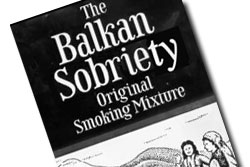 It’s a fact. I’m no historian. This is clearly evidenced anytime someone asks me a question like, "When did Balkan Sobranie disappear from the US market?" I know it happened within the last decade, but that’s about as specific as my memory gets. A historian would remember when things like this occur, accompanied by the context of the event, important influences that led up to it, and the event’s aftermath, and could paint a fairly elaborate picture of the mechanisms behind it all, the whys and hows and whens of the event.
It’s a fact. I’m no historian. This is clearly evidenced anytime someone asks me a question like, "When did Balkan Sobranie disappear from the US market?" I know it happened within the last decade, but that’s about as specific as my memory gets. A historian would remember when things like this occur, accompanied by the context of the event, important influences that led up to it, and the event’s aftermath, and could paint a fairly elaborate picture of the mechanisms behind it all, the whys and hows and whens of the event.
Certainly, something as important to the pipe world as the disappearance of a justifiably celebrated tobacco blend is a subject that I, as someone in the business, should be able to recall in an instant, and perhaps even expand upon with some windy, byzantine tale, told in hushed and reverent tones, replete with florid language, a colorful parade of adjectives and an archaic vocabulary. I cannot do this. I can scarcely remember when my own brands appeared or disappeared, or, for that matter, what I had for breakfast last Tuesday. I am, and always have been, a little historically challenged.
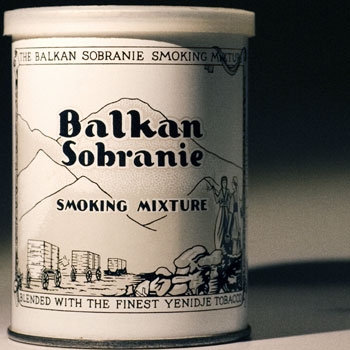 So, when thinking about a column on some of the changes that have befallen this celebrated tobacco throughout the years, I had to rely on research, and on reputable industry sources whose memories are better than mine, in order to attempt to assemble a credible picture of even some small part of the brand’s colorful history. What I quickly discovered is that I am not alone in having a somewhat fuzzy view, at least on this topic. It seems there is a nearly impenetrable veil of mystery shrouding the venerable Balkan Sobranie – perhaps more so than any other brand in the relatively short life of packaged pipe tobaccos. Of course, that sort of thing, that misty past, is part of the romance of our wonderful pastime, and it does tend to make for great stories, at least for those of us who enjoy the mystique, but it also makes sticking pins in the map challenging, and, worse, leads to a fair amount of misinformation blindly finding itself leaping from the "Idle Speculation" box to the one labeled "Absolute Fact."
So, when thinking about a column on some of the changes that have befallen this celebrated tobacco throughout the years, I had to rely on research, and on reputable industry sources whose memories are better than mine, in order to attempt to assemble a credible picture of even some small part of the brand’s colorful history. What I quickly discovered is that I am not alone in having a somewhat fuzzy view, at least on this topic. It seems there is a nearly impenetrable veil of mystery shrouding the venerable Balkan Sobranie – perhaps more so than any other brand in the relatively short life of packaged pipe tobaccos. Of course, that sort of thing, that misty past, is part of the romance of our wonderful pastime, and it does tend to make for great stories, at least for those of us who enjoy the mystique, but it also makes sticking pins in the map challenging, and, worse, leads to a fair amount of misinformation blindly finding itself leaping from the "Idle Speculation" box to the one labeled "Absolute Fact."
It’s impossible to provide, in such a short article, the complete story of a brand with as much history as this one, so there are certainly some rather large holes to be filled in what follows, and I’m certain that some amongst my readers will have useful information to add. Please do!
With the current amplification of interest in the marque, possibly kick-started by the newly released revisitation of the original blend, it might be interesting to look at its past through a somewhat different lens. This is certainly not intended to be some windy exegesis on the religious history of the company or the brand – lord knows, enough have trampled that topic – though some wandering through those gardens may be inevitable, if necessary to tell the story of some of the blend’s and the brand’s transformations over the decades.
I realize I’ve written on some of this before, and I’ll probably write about much of it again; there’s certainly a great deal of fertile and interesting ground to plow, but it seems that certain facts continue to go missing whenever the poetic waxing over this legendary tobacco begins. Let’s see if we can assemble a little picture that might be somewhat more coherent than the mythologies often presented, starting with a look towards the blend’s beginnings.
It’s difficult to fix a precise point in time when Balkan Sobranie Smoking Mixture first appeared, either for home trade in the UK, or for the export market. Those who romanticize the brand speak of it as though it has been around forever, or at least forever as it applies to modern pipe smoking, and some even allude to the fact that it existed as early as the 1920s. I’ve found no credible support for this claim, though the cigarettes bearing the name were certainly produced as early as 1897, and much of the earliest literature in which Balkan Sobranie is mentioned is, in fact, referring to those. In fact, the earliest reliable mention of the smoking mixture that I could find was an advert in a 1949 issue of The Strand (vol. 118), wherein it was stated, "For this is a tobacco that is not just a smoke but a way of living, not just another fill but another outlook, not just another brand but a bond that links you and your pipe forever to the surname Balkan Sobranie;" a wonderfully romantic image, and little wonder that some mystique exists to this day.
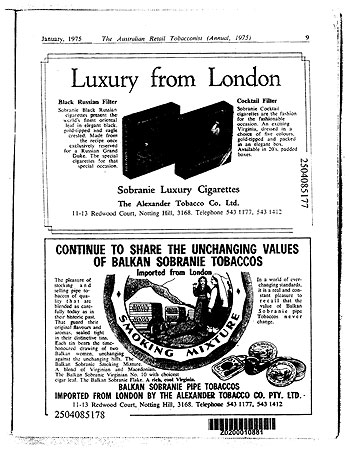 It’s likely that the tobacco was on market well before this date, but how long before is hard to say. A reliable source reports that it appeared sometime before WWII, and I’m continuing the research in this area. Whenever it began, this original Balkan Sobranie of olde was certainly quite different from the Balkan Sobranie of more recent memory. In fact, the tobacco has, since its inception, gone through more than a few changes, some necessitated by tobacco availability, others driven by other, less predictable motives. Probably, the most infamous of the more recent changes would have come about in the period starting ca. 1960, when the Syrian government initiated a moratorium on the country’s production of Latakia. World demand for the smoky treasure, at the time, was sufficient that Syria’s limited forests of the oak and stone pine woods used in the fumigation process were threatened with complete disappearance, so, manufacturers were forced into using its Cypriot cousin, produced from a different leaf, and smoked over a different blend of woods. While these tobaccos do share many traits, and both can be used to good effect in a mixture, they are, nonetheless, as different from one another as they are similar. Syrian has a vibrancy, and an almost fino sherry-like delicacy, along with resinous, spicy overtones and a very focused brightness. The Cyprian form is more leathery, smokier, heavier and more assertive, with a subtle background sweetness, and any mixture using it would be necessarily different.
It’s likely that the tobacco was on market well before this date, but how long before is hard to say. A reliable source reports that it appeared sometime before WWII, and I’m continuing the research in this area. Whenever it began, this original Balkan Sobranie of olde was certainly quite different from the Balkan Sobranie of more recent memory. In fact, the tobacco has, since its inception, gone through more than a few changes, some necessitated by tobacco availability, others driven by other, less predictable motives. Probably, the most infamous of the more recent changes would have come about in the period starting ca. 1960, when the Syrian government initiated a moratorium on the country’s production of Latakia. World demand for the smoky treasure, at the time, was sufficient that Syria’s limited forests of the oak and stone pine woods used in the fumigation process were threatened with complete disappearance, so, manufacturers were forced into using its Cypriot cousin, produced from a different leaf, and smoked over a different blend of woods. While these tobaccos do share many traits, and both can be used to good effect in a mixture, they are, nonetheless, as different from one another as they are similar. Syrian has a vibrancy, and an almost fino sherry-like delicacy, along with resinous, spicy overtones and a very focused brightness. The Cyprian form is more leathery, smokier, heavier and more assertive, with a subtle background sweetness, and any mixture using it would be necessarily different.
It’s probable that when the moratorium was first in effect, brokers and manufacturers warehoused as much of the Syrian leaf as they could find, and slowly, over the period of years, phased it out, replacing it incrementally with increasing amounts of Cypriot leaf. Depending on the percentage of Latakia in the blend, and the amount of Syrian leaf in stock, this might have taken a year or a decade. Certainly, by sometime well before 1980, there was no Syrian Latakia to be found in the blend in any quantity.
The year, 1980, further represents the start of another significant chapter in the Sobranie story, as this was the year when Gallaher acquired the brand in toto. There’s some reason to believe Gallaher had been manufacturing the blends under contract to Sobranie House for some time, and they were certainly manufacturing the cigarettes since some point in the early 1960s, but it’s clear from several sources that after 1980, the brand became Gallaher’s property, and they were free to do what they would with it. This is the point where things really began to change, as a so-called "rationalization" process commenced, taking place over the course of the following decade.
The most obvious of the changes was a drastic reduction of the Latakia content of the blend. As indicated by the chart in fig. 1, in 1980, the blend contained 50% Latakia by weight; by late 1982, this had been reduced to 35%. (Interestingly, during this period, the percentage of Latakia in the 759 mixture was also reduced, though from a high of 60% in 1980, see fig. 2, to a low of 35%, whilst the percentage in the Virginia #10 remained constant at 16%.) But, Latakia content does not tell the whole story, and other changes to the blend’s formulation were made, including the addition of blackened virginias, to minimize the visual and taste impact of this reduction, but it was, nevertheless, noticeable by those who were paying attention. (I still remember the conversations around the tobacco counter at Drucquer’s during this period. "It’s just not the same," was often repeated by those for whom the mixture had become a staple smoke.)
Fig. 1
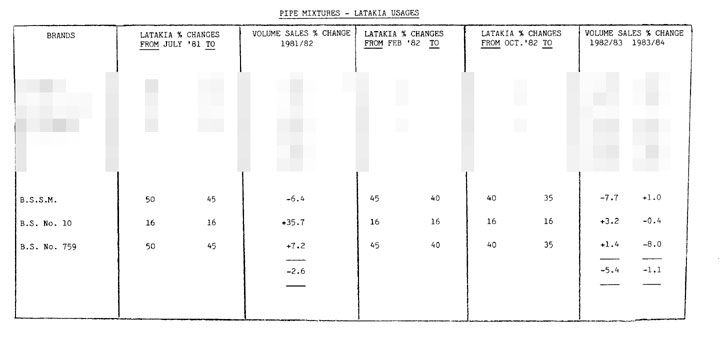
[Editor’s note: The above and below charts are actual company documents from Gallaher obtained from confidential industry sources, and are now in the PipesMagazine.com Archives. We have pixelated out information that is not relevant to this article. An easy to read larger version is viewable by clicking the above.]
Fig. 2

What’s less apparent is that the original formulation contained some 17 to 19 separate and discrete component tobaccos, making it a difficult and expensive mixture to produce, so the first phase of the rationalization process was put into effect, using oleos of orientals, darks, brights and so on – mini blends, in a sense – that could be used in other products they manufactured as well. Thus, the "new" mixture became something akin to a blend of blends, losing some of its character, and most notably, eliminating the specific oriental varietals, such as the long lauded Yenidje tobacco to which the original mixture owed much of its distinction. Additionally, during this period, the aging of the individual components prior to blending, as well as the aging of the blend itself prior to tinning, was reduced or eliminated.
Towards the end of this chapter, the packaging changed dramatically. The beautiful large, hermetically sealed tins, were replaced by tobacco in foil bags, stuffed into a less reliable screw-top metal container, and the small tins yielding to more economical, if far less elegant pouches. In short, by the time the blend disappeared from the US market, it bore little resemblance to what had been available prior to 1980. (During the 1990s, Isadore Redstone worked with another manufacturer, in concert with the distributorship of James B. Russell, to create Balkan Sasieni to a recipe and methodology more closely resembling the original – another story.) Gallaher pulled Balkan Sobranie off the US market in 1996, and finally discontinued it entirely in ca. 2005.
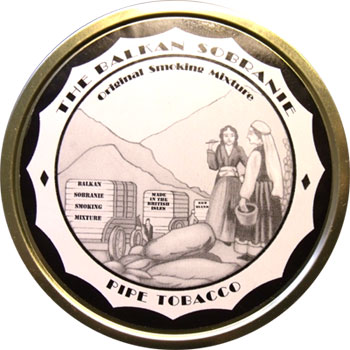 Even from this brief look into some of the changes that befell this singular mixture, it’s easy to find ourselves floundering in a sort of conundrum when discussion of this classic tobacco ensues. It seems that no other tobacco has been the basis for so much comparison to newer ones, or more widely "copied" than Balkan Sobranie, and therein we find ourselves in a pit of snakes. Never mind the fact that recreating a mixture based on an aged sample of it is nearly, if not completely unlikely, we further have to wonder, which version is being represented by the attempt? And, worse, it’s clear that when veteran pipe smokers talk about the Balkan Sobranie in reverent tones, it’s all but impossible to know, reliably, what they’re talking about. Two smokers, sharing stories of their experiences in different years with the stuff, might be talking about very different tobaccos.
Even from this brief look into some of the changes that befell this singular mixture, it’s easy to find ourselves floundering in a sort of conundrum when discussion of this classic tobacco ensues. It seems that no other tobacco has been the basis for so much comparison to newer ones, or more widely "copied" than Balkan Sobranie, and therein we find ourselves in a pit of snakes. Never mind the fact that recreating a mixture based on an aged sample of it is nearly, if not completely unlikely, we further have to wonder, which version is being represented by the attempt? And, worse, it’s clear that when veteran pipe smokers talk about the Balkan Sobranie in reverent tones, it’s all but impossible to know, reliably, what they’re talking about. Two smokers, sharing stories of their experiences in different years with the stuff, might be talking about very different tobaccos.
In closing, I’ll add that I am not in a position to discuss the recent reintroduction of this venerable brand, as I have no knowledge of its current composition or manufacturing processes, but my limited experience with it leads me to guess that its genesis is not likely in the pre-1980 version of the formula – nor could it be, as leaf sources are different – but in one of the later versions, so it is best to judge it solely for what it is, rather than compare it with what it is not. I’ve smoked Balkan Sobranie on and off over the past 30 years, having had examples from every period. Experientially, that the profound presence of Latakia is still evidenced in some abundance in very old tins of Sobranie is telling of the fact that it did, in fact, contain a higher percentage of the smoky stuff, but time alone will tell what this new release will become.
Your turn.
-glp
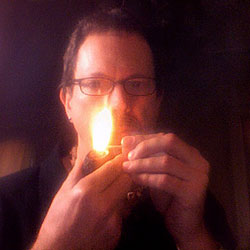 Since 1999, Gregory L. Pease has been the principal alchemist behind the blends of G.L. Pease Artisanal Tobaccos. He’s been a passionate pipeman since his university days, having cut his pipe teeth at the now extinct Drucquer & Sons Tobacconist in Berkeley, California. Greg is also author of The Briar & Leaf Chronicles, a photographer, recovering computer scientist, sometimes chef, and creator of The Epicure’s Asylum. See our interview with G. L. Pease here. |
















Greg I’ve said it before and now one more time. If you ever write a book I’ll buy it. You have a powerful
ability with words and this is just another example. This is the best Information I have ever read on the
subject. It’ royal highness, Sobranie, completely slipped by me and all my years smoking a pipe I never
tried it. I, therefore, do not miss it. It is hard to imagine a better tobacco product than the ones I enjoy now
Which includes a few by one Mr Pease and more recent creations by McClland . Thank you for this most
informative information. Papa John
A great read Greg!!
So much has been said previously on this long lamented blend. My own thoughts are that – It’s gone, never to return! Get over it!! There are so many excellent blends out there openly available. There was a tin of Balkan Sobranie on E-Bay recently, it went for astronomic money!! Now lets talk sensibly…..I love my pipe and the lovely tobacco blends I smoke BUT…I am just a working, family man. I cannot afford or justify spending ridiculous amounts on ONE tin of tobacco. Yes, I will try the new version but I doubt that it will ever replace the favourites I can buy readily. I am in the fortunate position of having a good friend Stateside who keeps me well supplied with the US blends I have come to love – Without the Bullshit, most of my favourites hold the name of GLP, McClelland, C&D. All producing excellent Latakia mixtures!! So come on guy’s….Support the blenders of the blends we can afford and are readily available!!
A marvelous article. It just goes to show that what you think you know and what the truth is can be two different things. Just because you are smoking Balkan Sobranie doesn’t mean you are smoking Balkan Sobranie.
But we have all seen this in numerous other blends where over time and changes of ownership has wreaked havoc on what the original blend was.
This is a great article. It explains much, but makes the mystique of the original even more powerful! All BS about BS aside, the quest to resurrect the memory did lead to the custom blending of some great tobaccos, including my favorite Lat blend, H&H Black House.
Great essay, Greg. I discovered this wonderful blend back in the early 70’s, and smoked it then. I tried 759 and didn’t care for it, but I smoked a lot of the original, back in those long ago days. Haven’t gotten a chance to try the new one,and won’t attempt to compare, because I just don’t remember. :puffy:
In spite of the high Latakia content I still regard the Original Mixture that I smoked in the early ’60’s as a subtle blend; would this be due to the use of Syrian at that time or the other Oriental components or the nature of the Virginia’s (or faulty taste memory)?
Why “smoking mixture”? Were there other additives that prohibited it being labelled “tobacco” under the Brit. former rules?
I stopped smoking it post Gallaher pouches when it was regarded as an OTC over this side of the pond (mixed well with Bruno rough Cut though!)
I’m with the guys above that think we are well served nowadays with new blends that don’t try and compete with the past. After all, even nostalgia isn’t what it used to be!
Thanks for a wonderful read about this storied blend. I’m all in favor of keeping the romance in this hobby alive. Now, where is that tin of Westminster I had squirreled away? 🙂
A good read, but I dislike the excessive nostalgia blends can acquire. It is misleading. I’m not a frequent Latakia man, but the tastiest I’ve tried is Night Cap, by a long, long way. I was amazed how good it was and most pipe smokers I’ve talked too, agree. I really doubt Balkan S. could be that much better, different of course, a little nicer, perhaps. One thing I have learnt, is never believe the hype.
I enjoy reading and learning about the blends of olde, and wishing that I too could enjoy those savory smokes. So thanks for the history. Think I will have some Meridian. 🙂
Well I guess it was necessary that Mr. Pease put this article together. I feel that it may bring some closure to the hype that was brought on by the infamous ‘Throwndown’ sponsore by a most gracious pipe club. It is my opinion that any quality tobacco that was good enough to shelve for around 30 years could have been a model for the contest. Yes I did smoke Sobranie pipe tobacco. I smoked it when I was in my late teens. I had no idea about the stuff except that the tin art was really cool to me and it was full of that stuff that smelled up the tobacco shop that I frequented and that too encouraged me to buy a tin each time I was at that mall which was at at least weekly.
The blend that is available today is similar at best. It did bring back memories but then there are other latakia/oriental/VA blends that do the same thing. For me any English blend will bring back memories because this is what I grew up around and those days were good days. Of course a taste and aroma is going to take me back. Those were good days. My point? ENOUGH! I’m saying enough of tryin to compare apples and oranges. There was a contest. It was fun. There was a winner. Game over.
My congratulations to Mr. Pease for a tremendously insightful article, as well as to the many different investigators whose efforts to shed light on the history of this company and its illustrious blends could not go unmentioned. This is indeed a most informative summary of different studies, namely the author’s own articles on these and other intimately related themes. In my view, there exists nothing comparable to the astute treatment that an experienced blender and avid researcher can offer: his contribution has been of considerable weight in this combined effort to understand tobacco in the many variables that define it; contrary to the popular and most unaware conception of near absolute immutability.
I would like to add some of my thoughts with reference to this matter, if I’m permitted?
This piece raises an important point regarding the commonly remarked subtlety of true Syrian Latakia and how that momentous event in which it was gradually brought to an end changed the face of (British) tobacco. The results of my own research, performed with the aid of several blenders working in the U.K., appear to explain the unprecedented lows in Latakia leaf use – that minute 5% portion Sherman alludes to when scrutinizing the “typical English” formula – as a result of the conspicuous differences between the potent Cyprian and the subtle Syrian. It is no coincidence that different producers followed this downward curve in what refers to the conditioned usage of Latakia in their blends over the years: while this has often been attributed solely to the alarming scarcity of Syrian leaf in stock, many fail to acknowledge this simple realization that an inherently strong-flavored Latakia would hence be used in more cautious proportions.
Numerous factors exert their influence during this critical phase. Even if serious limitations pertaining the period allotted for tobacco producers to store and mature their product arose during the 1970’s in England, it is also known that tobacco warehouses continued to preserve larger quantities for periods of time that could not compare with the present day reality. In fact, many believe that this outsourcing phenomenon witnessed in the early 1980’s – one that even affected Dunhill, leading to the Murray years – is deeply related with an attempt to evade the punitive government regulations then felt in that country. However saddening, politicians and legislators often came to exercise a degree of influence on tobacco larger than that of blenders themselves.
As much as this may seem incomprehensible to some, History encompasses all: and that must forcefully include myth alongside everything else. I see no reason why myth cannot be preserved if presented as such.
As I’ve said on occasion, I hold the current (re)production of the blend in high esteem, especially when compared to the previous incarnation of Balkan Sobranie whose packets were still being sold in small tobacconists near the Spanish border, neatly preserved inside cigar humidors as I discovered two years ago. That deplorable handling of the blend, in itself, appeared to have made one final stab at this legendary reference and the excellence it once boasted. To witness the Balkan Sobranie production being passed to what is possibly the last great stronghold of uniquely English tobacco (although located in Jersey) does fill me with much hope in these times of evident decline. Then again, the factory of J. F. Germain & Son does not only benefit from its own legacy; yet also from a singular, almost sacrosanct safeguarding of conventional methods, now widely held as obsolete.
Given their privileged geographic position, they’re also allowed to evade the same governmental impositions that significantly disturbed tobacco blending throughout the last decades. Indeed we should rejoice for, somehow, all factors did combine favorably so we could be greeted with what is arguably the most genuine Balkan Sobranie reproduction of recent memory. Bearing in mind the all the aforementioned vicissitudes, I for one fail to conceive of a more ideal turn of events.
Thank you.
Nice article, Greg. I find the fascination with out of product blends amusing considering how it isn’t as if there is a dearth of good blends today. In fact, the opposite is true. If you can’t find your be-all-end-all blend amongst those available from GLP, C&D, McClelland, Hearth & Home, Sam Gawith, Gawith Hoggarth, Esoterica, etc. then it ain’t out there.
Thank you, gentlemen, for the kind comments. There’s so much more that could have been said, but I was already running up against the point where I was afraid the readers might need a third cup of coffee. The only thing greater than the legendary stature of this brand is the level of myth and misinformation that continues to be promulgated about it.
For instance, a certain blender has gone to some length to insist that Balkan Sobranie Virginia #10 never contained any Latakia, when it is not only quite evident in my smoking of examples from many eras, but also clearly shown in the table above (fig. 1) as present in no small percentage.
Yes. So much more could have been said… I’ll crawl back into my underground lair, now.
Bruno, thanks for your thoughts. Though I could not agree more that Syrian and Cyprian latakia must be handled differently in a blend, my experience is actually somewhat different with respect to which one sings with the louder voice. Cyrpian, by virtue of deeper basso, if you’ll allow me to continue with my analogy, can rattle the walls, but can also be tolerated in greater measure in a blend, while Syrian, with it’s brighter mezzo carries farther with greater ease, and can become overbearing and a fatiguing if not used more sparingly. It’s less a matter of degree, I think, than it is a matter of pitch, in this sense.
As to the value of myth in our romantic pastime, I also tend to agree. Where we have problems is when myth is treated as fact. One can tell another of their great beauty, whether or not they actually possess it, but when the object of that adoration begins to believe the innocent and well-intended flattery, they very likely will become insufferable.
Thank You Mr. Pease for a very informative article, I have only read about Balkan Sobranie Original Smoking Mixture and the information from other smokers. I have read and heard that this particular blend was what all tobaccos were measured with and the laments of it not being available anymore. I can be guilty in being caught up in the nostalgia of certain things only to be disappointed when those things are introduced again. So what Im going to do is to try the new version of this particular blend and if it is to my liking then I will be happy and buy and smoke more, And isn’t this really what it is all about anyway?
Great article, Greg. I smoked the original BS back in the late ’70’s, but haven’t had a chance to try the new version yet. When I do get the chance, I’ll just have to judge it on it’s own merits because it’s been way too long ago for me to remember exactly what the original tasted like. I guess I’m kinda like you, I can’t remember what I had fro breakfast last Tuesday either. 😉
Greg–While somewhat off topic, you referred in this article to Drucquer’s, where I gather you learned the tobacco trade, so to speak. It would be grand if you could do a story on this “house,” the variety of tobaccos they tinned, all with the terrific personal accounts that could make this more than a list of past offerings.
Thanks much
Bob Silverman
Dear Greg,
It would be very interesting to hear you tell the other story – about Balkan Sasieni. I hope we won’t have to wait too long.
Very well done, Greg! It might be shocking to readers that a great blend can have 60% Latakia. Aha, but it’s the quality of the Lat.
I don’t think this topic could’ve finished any better than this. What a great review and info on the Gallaher’s documents provided for us to view. Reading this article brings to light that what was may never be again. So let’s enjoy the fond memories of the past and enjoy the new beginnings of some fine recreations.
Thanks Greg.
Andy C.
Great story Greg. I’d like to toss a vote in too for an article on Balkan Sasieni.
This article raises the question again about the need for some type of standard for truth in branding. I thought of Three Nuns as another blend where key components were changed. It seems that in the pipe tobacco world companies are totally free to be misleading with no accountability to truth in advertising. It’s one thing for blends to experience subtle changes due to mother nature’s affect on the leaf, but when actual tobaccos are removed, added, reduced or increased it fundamentally creates a new blend. Maybe the FDA can address this issue? ha ha.
As a Latakia Lover, I Love both forms, and can definitely relate with the analogy Mr. Pease presented to DailyPuffer. Two thoroughly enjoyable pieces from two wonderfully stimulating minds.
I am eagerly awaiting a chance to procure the new mixture. Not because I loved the old. I never smoked it. I just love to try new blends, and if Germaine is behind it, It is sure to be, at the least, interesting, and of high quality.
I would be remiss if I did not give the nod to Mr. Pease, and his latakia based blends, which continue to satisfy to my palate.
Greg:
Great article on the evolution of the blend over time, and the factors which drove various changes. I enjoyed it very much.
A couple of quick corrections: the original Smoking Mixture does indeed date from the 1920’s, as a variety of documents attest. For various reasons it was clearly launched between 1922 and 1929, with my educated guess being very probably the tail end of that period (i.e. 1929); certainly that’s when the UK trademark was issued (Mark #507001 filed October 17, 1929). And of course there are contemporaneous newspaper advertisements for the blend to be found as early as that year.
As for Gallaher’s involvement in manufacturing of Sobranie products, they didn’t take over portions of the cigarette line (primarily the cheaper brands) until they bought them from Sobranie in 1968. Likewise the pipe tobaccos continued to be manufactured by Sobranie in its Edmonton facility in suburban London until Gallaher bought them in the second transaction (which as you mention occurred in 1980). At that time the Edmonton factory was shut (and subsequently occupied by a start-up called the London Tobacco Company), and Sobranie blend pipe tobacco production was shifted to Gallaher’s Belfast plant on York Street. Eventually with the closure of the York plant production was shifted to Gallaher’s more modern facility in Lisnafillan.
I got a tin ofthe new reintroduced blend and after smoking 2 bowls of it I am not so happy to say hat it did not meet my high expectations. I found the blend weak and the cut not very nice to,fill in to the pipe. Abingdon from master Pease is in my opinion a much better blend for true english and alkan aficcionados like me. I also recommend mclelland blends eith latakia and ten rusisians for the latakia bomb lover of for a source of spicin up other blends with higher latakia contents. Cheers. Fab
Thank you, Jon, for your excellent historical corrections. I wasn’t able to find anything older than 1946 (which I found after the article was already published, and as I couldn’t get a good fix on the source, I felt I couldn’t use it anyway), and am happy to know that there is something to support the pipe mixture’s existence in the 1920s. I’d love to have a jpg for my files of one of those old advertisements, if you have one and are willing to share. Fascinating stuff, and great information on the transfer of production in Ireland.
Greg:
No problem; on its way. It’s part of a much larger chron file for the article on the company’s history that I’m wrapping up.
Best,
Jon
Awesome. Thanks, Jon!
Just wondering how those of you who have experienced both the latest Balkan Sobranie and Black House blends would compare the two.
Harkpuff
@harkpuff – There is no comparison to be made here as they are not even trying to represent the same thing. Balkan Sobranie is one blend, and Balkan Sobranie 759 are two completel different blends. Black House was the winner of the contest to try to come the closest to representing an aged sample of the 759 blend. The new Balkan Sobranie release is supposed to be representative of the original Balkan Sobranie, NOT Balkan Sobranie 759. Some people feel that G.L. Pease Meridian comes very close to the original Balkan Sobranie.
Hi harkpuff.
I have smoked Black House and the new Sobranie. A couple bowls of both which is not much but enough to give you at least a tentative opinion. I should state at the outset that comparing the new Sobranie with Black House is a bit inappropriate. Black House was blended to resemble Balkan Sobranie 759 and not the Balkan Sobranie Original (a different blend) so it is not really a fair comparison, as Black House seems to have more Latakia, just as 759 had more Latakia than the Sobranie Original. Black House is a bit richer to my taste although the new Sobranie seems to me to be maybe a bit more smooth. To my taste, I prefer Black House because it has more richness.
I seem to be in the minority in that I am not impressed with the new Sobranie. It is smooth to be sure but lacks richness, depth and complexity in my opinion. I must say I was disappointed but not surprised. The new Sobranie may be made from the same recipe but it is definitely not made from the same tobaccos as the original Sobranie, which have not been available for a long time and never will be again, barring some miracle (we can always pray). The ingredients of a blend are crucial, in my opinion, and generally speaking more important than the recipe.
I doubt if this helps with your question but that is my view, for what it’s worth.
Fred
Thanks Fred and Kevin! Yes, your responses have helped clarify this for me. I guess I was under the assumption from other articles that I had read that 759 was also a later attempt to match the original recipe as well. I had no idea that it was a completely different recipe. I am considering trying some Black House and was just curious how they compared to each other.
Back to the new Sobranie: I have tried it and felt that it compares somewhat in flavor and aroma to 1776 Tavern which is a Heavy English made by 1776 Tobacco Company. The Pease article above mentions Yenidje tobacco which is one of the ingredients to 1776. I am nearly out of 1776 and plan on ordering more. It is the most expensive blend that 1776 Tobacco offers and I imagine it is so costly because 1776 Tavern is advertised as containing several tobaccos such as Turkish Mahala, Yenidje Broad cut, Samsoun, Cavalla, Dubek, Red Virginia, Burley, and Latakia.
When I first opened my tin of Sobranie, my first impression was that it reminded me very much of the 1776 Tavern that I have been smoking. In comparing the two, I actually like that 1776 Tavern better, feeling that it is a little richer in flavor.
Thanks again!
Harkpuff
Thanks for the info! i love smoking!
Well done. A remarkably well put together piece. I have find through a tin of the new BS, and, like Fred, I was not impressed. My mainstays these days are Star of the East, Pirate Kake, Westminster, Odyssey, and Balkan Sasieni. These blends provide a wonderful range of Latakia flavors for me. Thanks Greg for a very insightful article.
Ive had some of the very old blends of this and liked them the ones ive tryed from the early 2000s were different still good just different its a blend i enjoy very much